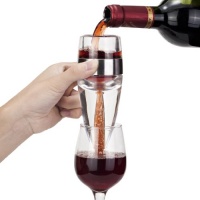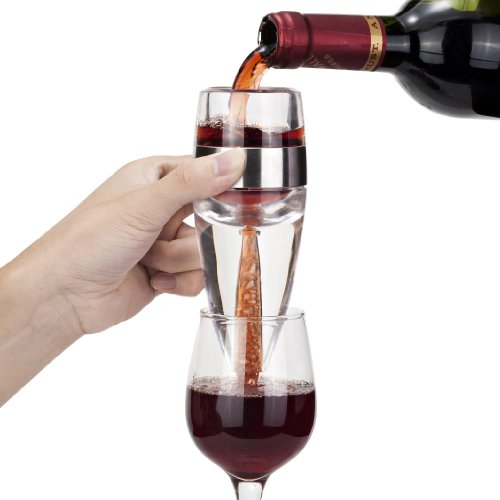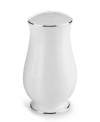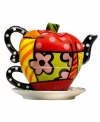$49.95
FEATURES OF THE VINOULLI WINE AERATOR: The Vinoulli wine aerator is functional as well as being stylish and makes a great conversation topic at any dinner party. It is supplied in an elegant presentation box and makes the ideal gift for any celebration. The aerator can be dismantled for ease of cleaning and comes complete with a sediment filter, drip stand, instruction leaflet and a velvet drawstring travel bag so that you can take it with you to restaurants, dinner parties or anywhere else wine is served! The Vinoulli wine aerator is designed to prevent leaking and dripping - unlike some other aerators on the market. It has a pouring chamber, which regulates the wine flow into the venturi funnel without any spills. As the wine passes through the funnel it makes a pleasant gurgling noise as the wine is infused with air during the aeration process, to make the perfect glass of wine every time.WHAT IS WINE AERATION? It is common knowledge amongst wine aficionados that aeration and decanting are the best way to enjoy the perfect glass of wine. However, wine aeration and decanting serve two different purposes: aeration lets wine breathe by exposing it to air, whereas decanting filters sediment from the wine. The structure of wine is extremely complex, containing hundreds of compounds, but the fruit character that provides a large proportion of the desirable flavors and aromas come from a relatively small portion of them. The aeration process triggers oxidation and evaporation which help to get rid of the wine's undesirable components such as sulfur compounds and ethanol. This then allows the more desirable flavors and aromatic compounds of the wine to dominate - and the greater the surface area of the wine, the more this will happen. Pouring your wine into the chamber of the device and through the venturi aeration funnel into a glass or carafe dramatically shortens the lengthy process of pouring the wine into a traditional decanter - to increase the surface area - and then waiting for up to an hour for the oxidation and evaporation processes to release the bouquet and tastes of the wine.HOW DOES THE VINOULLI AERATOR WORK? The Vinoulli wine aerator is named after the Swiss mathematician Daniel Bernoulli (1700 - 1782), whose most important work - the Bernoulli principle - outlined the basic properties of fluid flow, pressure, density and velocity. The Bernoulli principle has been applied in the patented design of the Vinoulli wine aerator and is used to control the flow of wine through the top chamber and then into the precisely engineered tapered venturi funnel, which uses pressure to force air through the liquid. This ensures that the right amount of oxygen is allowed to permeate the wine whilst not letting the wine become over oxygenated. This prevents unwanted acceleration of the oxidation process - which can cause the wine to lose its brightness in coloring and flavor as well as developing drier, bitter characteristics.DOES WINE AERATION REALLY WORK? One of the main debates regarding wine aeration is whether or not any noticeable difference in the aroma and flavor of aerated wine can be detected. The main reason for this is the fact that taste is a relative thing and not everyone perceives flavors and smells to the same degree. Suffice to say - whether you think wine aeration works or not - that vineyards and vintners, sommeliers and wine connoisseurs have for many years used wine aeration techniques to enhance their wine drinking experience. Another question often asked is "When should you aerate wine?" Typically, younger red wines - for example, Cabernet Sauvignons, Syrahs, Bordeaux and Barolos - are examples of the ones that benefit most from aeration - however, there are certain whites - Chenin, Burgundy and even Chardonnay that will also improve with aeration. As a rule of thumb, the younger and more dense and concentrated a wine is, the more it will benefit from aeration and the longer it can last before beginning to fade. You probably don't want or need to aerate delicate older wines (15+ years vintage) as they can lose their fruit during aeration as they can evolve in the glass and can quite quickly suffer from oxidation.THE SCIENTIFIC EVIDENCE: Science provides us with evidence that aeration is chemically beneficial to wine and also explains what happens to wine when it is exposed to air during the aeration process. Because the composition of air is complex, as is the structure of wine, the comprehensive chemical reactions that occur during aeration are beyond this brief summary. However, the more applicable effects of aeration can be highlighted to support the argument for wine aeration. One of the main benefits of aeration is the evaporation of excess sulfur dioxide, which is added during wine fermentation as protection against unwanted oxidation and also acts as an inhibitor to the growth of bacteria. Another element that is reduced by aeration is sulphides, which can form naturally during winemaking and also in the bottle, and has the distinctive rotten egg smell associated with sulfur. Other less desirable compounds such as sulphites, tannins and heavy yeast influences are also diminished by aeration. In some cases, such as with tannins, aeration does not actually remove these chemicals but reduces their influence and allows the more desirable, fruit characteristics of the grape to emerge.
No properties for this product.





